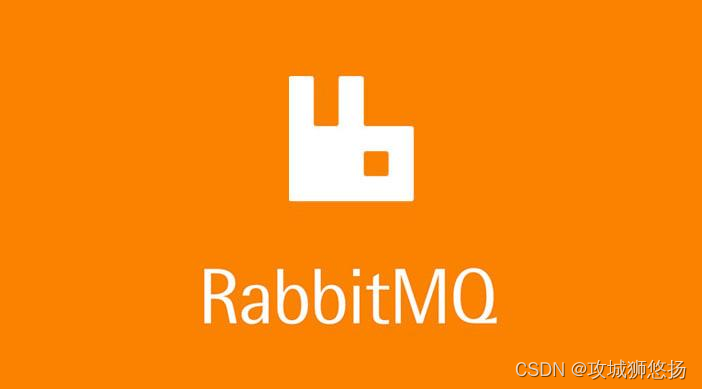消息中间件——RabbitMQ(七)高级特性 2
前言
上一篇消息中间件——RabbitMQ(七)高级特性 1中我们介绍了消息如何保障100%的投递成功?,幂等性概念详解,在海量订单产生的业务高峰期,如何避免消息的重复消费的问题?,Confirm确认消息、Return返回消息。这篇我们来介绍下下面内容。
- 自定义消费者
- 消息的限流(防止占用内存过多,节点宕机)
- 消息的ACK与重回队列
- TTL消息
- 死信队列
1. 自定义消费者
1.1 消费端自定义监听
我们一般就在代码中编写while循环,进行consumer.nextDelivery方法进行获取下一条消息,然后进行消费处理!
但是这种轮训的方式肯定是不好的,代码也比较low。
- 我们使用自定义的Consumer更加的方便,解耦性更加的强,也是在实际工作中最常见的使用方式!

1.2 代码演示
1.2.1 生产者
public class Producer {
public static void main(String[] args) throws Exception {
//1 创建ConnectionFactory
Connection connection = ConnectionUtils.getConnection();
Channel channel = connection.createChannel();
String exchange = "test_consumer_exchange";
String routingKey = "consumer.save";
String msg = "Hello RabbitMQ Consumer Message";
for(int i =0; i<5; i ++){
channel.basicPublish(exchange, routingKey, true, null, msg.getBytes());
}
}
}
1.2.2 消费者
public class Consumer {
public static void main(String[] args) throws Exception {
// 创建ConnectionFactory
Connection connection = ConnectionUtils.getConnection();
Channel channel = connection.createChannel();
String exchangeName = "test_consumer_exchange";
String routingKey = "consumer.#";
String queueName = "test_consumer_queue";
channel.exchangeDeclare(exchangeName, "topic", true, false, null);
channel.queueDeclare(queueName, true, false, false, null);
channel.queueBind(queueName, exchangeName, routingKey);
//实现自己的MyConsumer()
channel.basicConsume(queueName, true, new MyConsumer(channel));
}
}
1.2.3 自定义类:MyConsumer
public class MyConsumer extends DefaultConsumer {
public MyConsumer(Channel channel) {
super(channel);
}
//根据需求,重写自己需要的方法。
@Override
public void handleDelivery(String consumerTag, Envelope envelope,
AMQP.BasicProperties properties, byte[] body)
throws IOException {
System.err.println("-----------consume message----------");
//消费标签
System.err.println("consumerTag: " + consumerTag);
//这个对象包含许多关键信息
System.err.println("envelope: " + envelope);
System.err.println("properties: " + properties);
System.err.println("body: " + new String(body));
}
}
1.3 打印结果
2. 消费端限流
2.1 什么是消费端的限流?
- 假设一个场景,首先,我们Rabbitmq服务器有上万条未处理的消息,我们随便打开一个消费者客户端,会出现下面情况:
- 巨量的消息瞬间全部推送过来,但是我们单个客户端无法同时处理这么多数据!这个时候很容易导致服务器崩溃,出现故障。
为什么不在生产端进行限流呢?
因为在高并发的情况下,客户量就是非常大,所以很难在生产端做限制。因此我们可以用MQ在消费端做限流。
- RabbitMQ提供了一种qos(服务质量保证)功能,即在非自动确认消息的前提下,如果一定数目的消息(通过基于consume或者channel设置Qos的值)未被确认前,不进行消费新的消息。
在限流的情况下,千万不要设置自动签收,要设置为手动签收。 - void BasicQos(uint prfetchSize,ushort prefetchCount,bool global);
参数解释:
prefetchSize:0
prefetchCount:会告诉RabbitMQ不要同时给一个消费者推送多于N个消息,即一旦有N个消息还没有ack,则该consumer将block掉,直到有消息ack。
global: true\false 是否将上面设置应用于channel,简单点说,就是上面限制是channel级别还是consumer级别。
prefetchSize和global这两项,rabbitmq没有实现,暂且不研究prefetch_count在no_ask = false的情况下生效,即在自动应答的情况下这两个值是不生效的。
第一个参数:消息的限制大小,消息多少兆。一般不做限制,设置为0
第二个参数:一次最多处理多少条,实际工作中设置为1就好
第三个参数:限流策略在什么上应用。在RabbitMQ一般有两个应用级别:1.通道 2.Consumer级别。一般设置为false,true 表示channel级别,false表示在consumer级别
2.2 代码演示
2.2.1 生产者
public class Producer {
public static void main(String[] args) throws Exception {
//1 创建ConnectionFactory
Connection connection = ConnectionUtils.getConnection();
Channel channel = connection.createChannel();
String exchange = "test_qos_exchange";
String routingKey = "qos.save";
String msg = "Hello RabbitMQ QOS Message";
for(int i =0; i<5; i ++){
channel.basicPublish(exchange, routingKey, true, null, msg.getBytes());
}
}
}
2.2.2 消费者
public class Consumer {
public static void main(String[] args) throws Exception {
//1 创建ConnectionFactory
Connection connection = ConnectionUtils.getConnection();
Channel channel = connection.createChannel();
String exchangeName = "test_qos_exchange";
String queueName = "test_qos_queue";
String routingKey = "qos.#";
channel.exchangeDeclare(exchangeName, "topic", true, false, null);
channel.queueDeclare(queueName, true, false, false, null);
channel.queueBind(queueName, exchangeName, routingKey);
//1 限流方式 第一件事就是 autoAck设置为 false
//设置为1,表示一条一条数据处理
channel.basicQos(0, 1, false);
channel.basicConsume(queueName, false, new MyConsumer(channel));
}
}
2.2.3 自定义类:MyConsumer
public class MyConsumer extends DefaultConsumer {
private Channel channel ;
public MyConsumer(Channel channel) {
super(channel);
this.channel = channel;
}
@Override
public void handleDelivery(String consumerTag, Envelope envelope, AMQP.BasicProperties
properties, byte[] body) throws IOException {
System.err.println("-----------consume message----------");
System.err.println("consumerTag: " + consumerTag);
System.err.println("envelope: " + envelope);
System.err.println("properties: " + properties);
System.err.println("body: " + new String(body));
//需要做签收,false表示不支持批量签收
channel.basicAck(envelope.getDeliveryTag(), false);
}
}
2.2.4 测试结果
我们先注释掉:channel.basicAck(envelope.getDeliveryTag(), false);然后启动Consumer。
查看Exchange
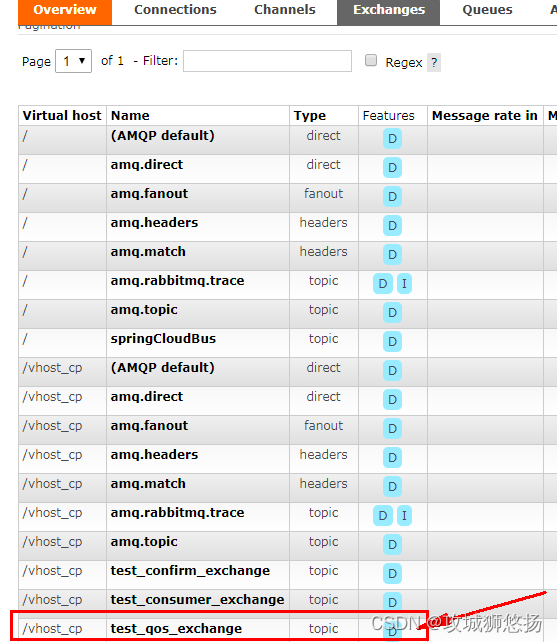
查看Queues
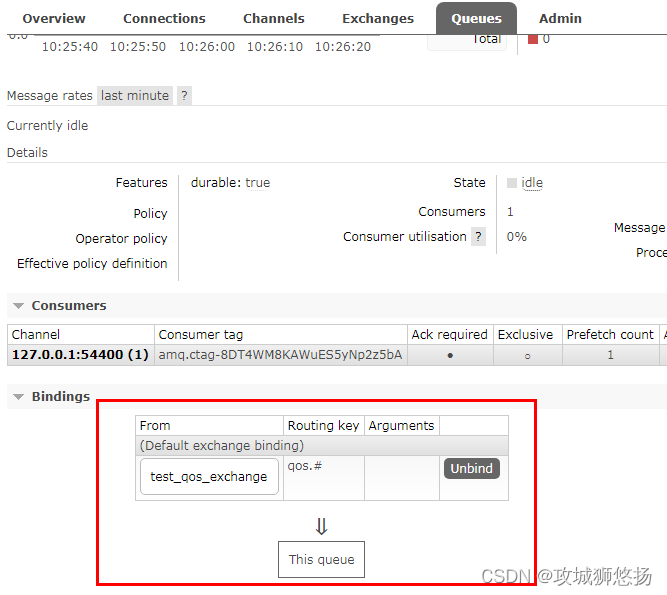
然后再启动Producer。查看打印结果:

我们会发现消费端,只收到了一条消息。这是为什么呢?
第一点因为我们在consumer中
channel.basicConsume(queueName, false, new MyConsumer(channel));第二个参数设置为false为手动签收。
第二点在qos中设置只接受一条消息。如果这一条消息不给Broker Ack应答的话,那么Broker会认为你并没有消费完这一条消息,那么就不会继续发送消息。
channel.basicQos(0, 1, false);
可以看下管控台,unack=1,Ready=4,total=5.
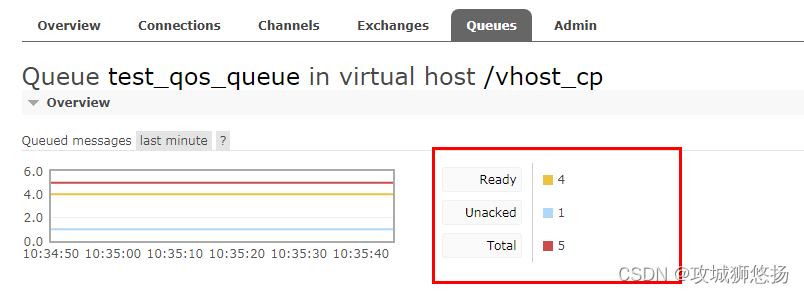
接下来我们放开注释channel.basicAck(envelope.getDeliveryTag(), false); 进行消息签收。重启服务。
3.1 打印结果

可以看到正常打印五条结果
4. 消费端ACK与重回队列
4.1 消费端的手工ACK和NACK
消费端进行消费的时候,如果由于业务异常我们可以进行日志的记录,然后进行补偿!
如果由于服务器宕机等严重问题,那我们就需要手工进行ACK保障消费端消费成功!
4.2 消费端的重回队列
消费端重回队列是为了对没有处理成功的消息,把消息重新传递给Broker!
一般我们在实际应用中,都会关闭重回队列,也就是设置为False.
4.3 代码演示
4.3.1 生产者
public class Producer {
public static void main(String[] args) throws Exception {
//1创建ConnectionFactory
Connection connection = ConnectionUtils.getConnection();
Channel channel = connection.createChannel();
String exchange = "test_ack_exchange";
String routingKey = "ack.save";
for(int i =0; i<5; i ++){
Map<String, Object> headers = new HashMap<String, Object>();
headers.put("num", i);
//添加属性,后续会使用到
AMQP.BasicProperties properties = new AMQP.BasicProperties.Builder()
.deliveryMode(2) //投递模式,持久化
.contentEncoding("UTF-8")
.headers(headers)
.build();
String msg = "Hello RabbitMQ ACK Message " + i;
channel.basicPublish(exchange, routingKey, true, properties, msg.getBytes());
}
}
}
4.3.2 消费者
public class Consumer {
public static void main(String[] args) throws Exception {
//1创建ConnectionFactory
Connection connection = ConnectionUtils.getConnection();
Channel channel = connection.createChannel();
String exchangeName = "test_ack_exchange";
String queueName = "test_ack_queue";
String routingKey = "ack.#";
channel.exchangeDeclare(exchangeName, "topic", true, false, null);
channel.queueDeclare(queueName, true, false, false, null);
channel.queueBind(queueName, exchangeName, routingKey);
// 手工签收 必须要关闭 autoAck = false
channel.basicConsume(queueName, false, new MyConsumer(channel));
}
}
4.3.3 自定义类:MyConsumer
public class MyConsumer extends DefaultConsumer {
private Channel channel ;
public MyConsumer(Channel channel) {
super(channel);
this.channel = channel;
}
@Override
public void handleDelivery(String consumerTag, Envelope envelope, AMQP.BasicProperties properties, byte[] body) throws IOException {
System.err.println("-----------consume message----------");
System.err.println("body: " + new String(body));
try {
Thread.sleep(2000);
} catch (InterruptedException e) {
e.printStackTrace();
}
if((Integer)properties.getHeaders().get("num") == 0) {
//Nack三个参数 第二个参数:是否是批量,第三个参数:是否重回队列(需要注意可能会发生重复消费,造成死循环)
channel.basicNack(envelope.getDeliveryTag(), false, true);
} else {
channel.basicAck(envelope.getDeliveryTag(), false);
}
}
}
5.1 打印结果:
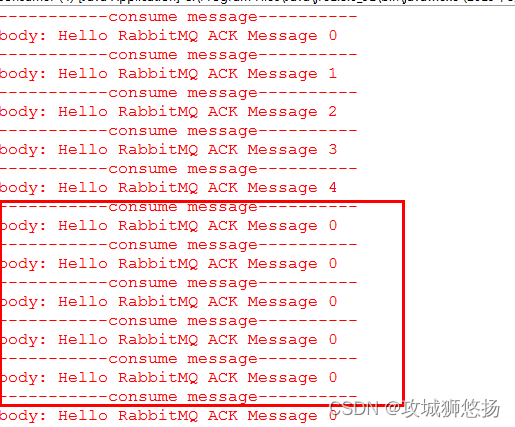
注意:
可以看到重回队列会出现重复消费导致死循环的问题,这时候最好设置重试次数,比如超过三次后,消息还是消费失败,就将消息丢弃。
6. TTL队列/消息
6.1 TTL
- TTL是Time To Live的缩写,也就是生存时间
- RabbitMQ支持消息的过期时间,在消息发送时可以进行指定
- RabbitMQ支持队列的过期时间,从消息入队列开始计算,只要超过了队列的超时时间配置,那么消息会自动的清除
6.2 代码演示
6.2.1 直接通过管控台进行演示
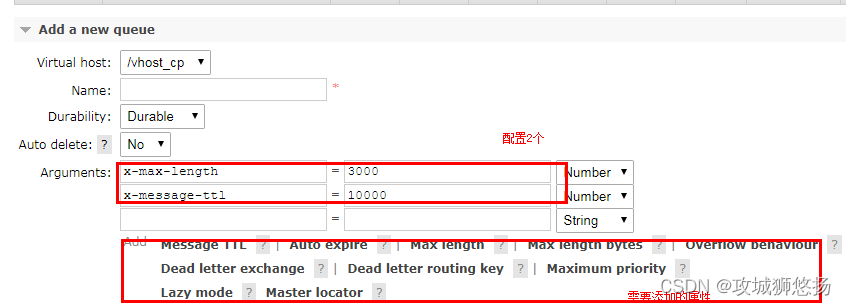
通过管控台创建一个队列
x-max-length 队列的最大大小
x-message-ttl 设置10秒钟,如果消息还没有被消费的话,就会被清除。
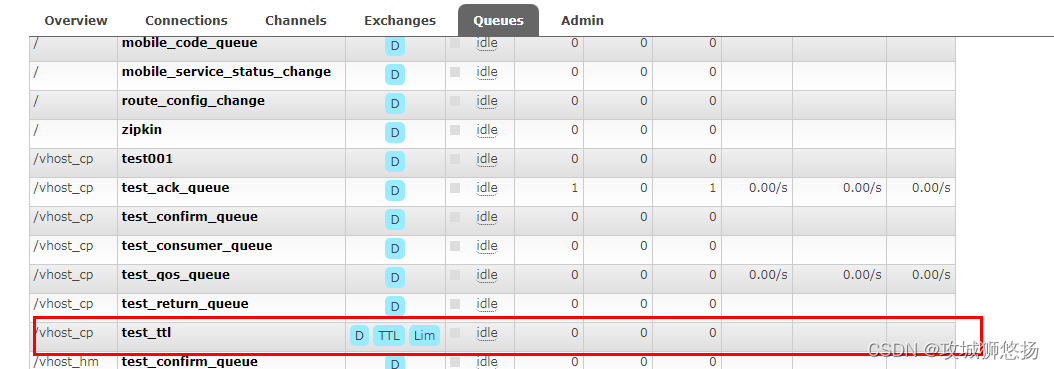
添加exchange
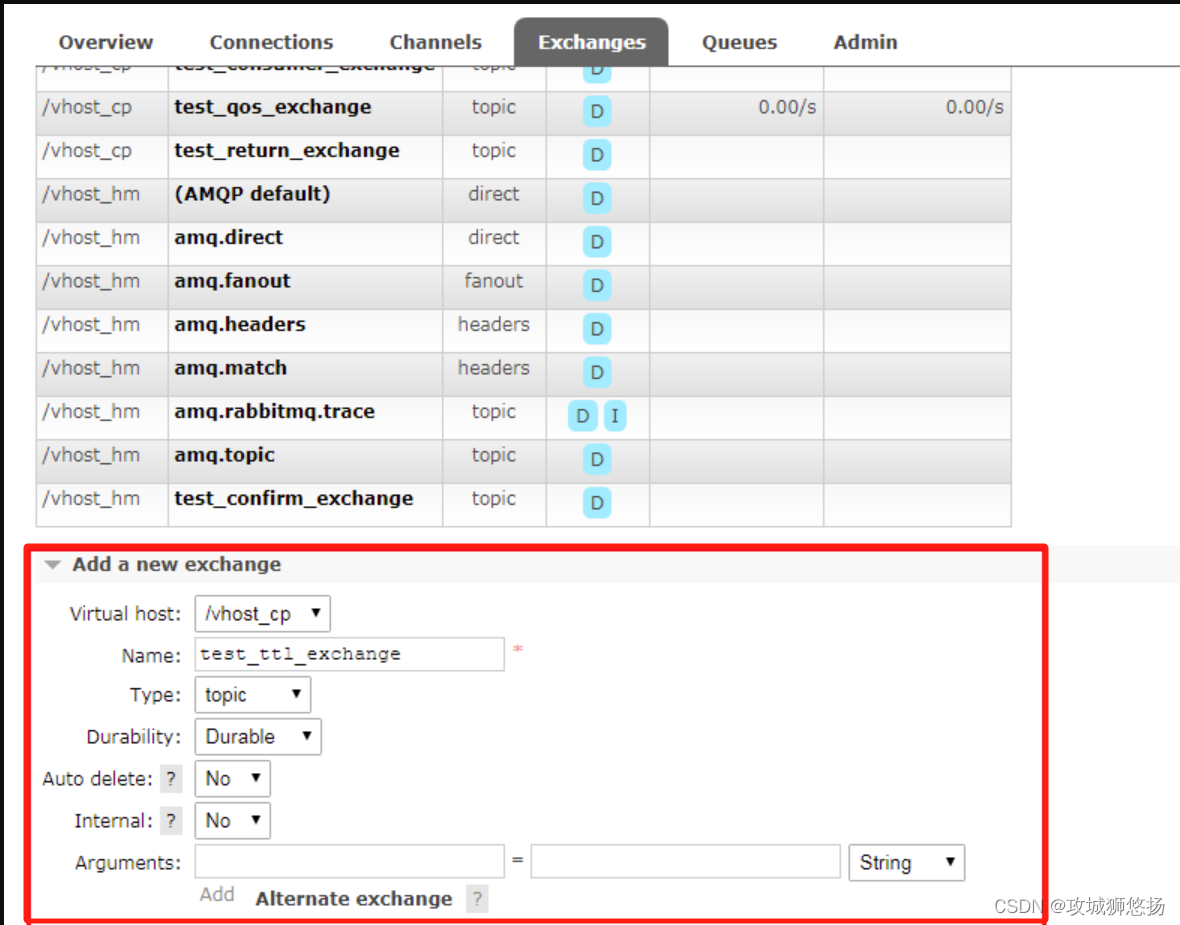
Queue与Exchange进行绑定
点击 test_ttl_exchange 进行绑定
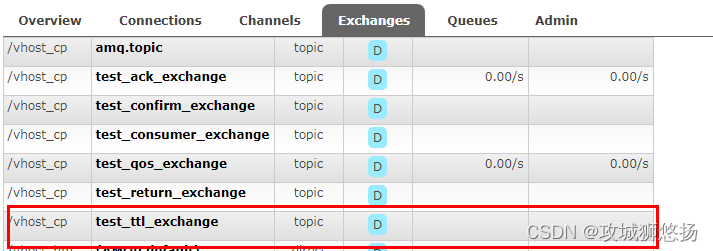
查看是否绑定成功
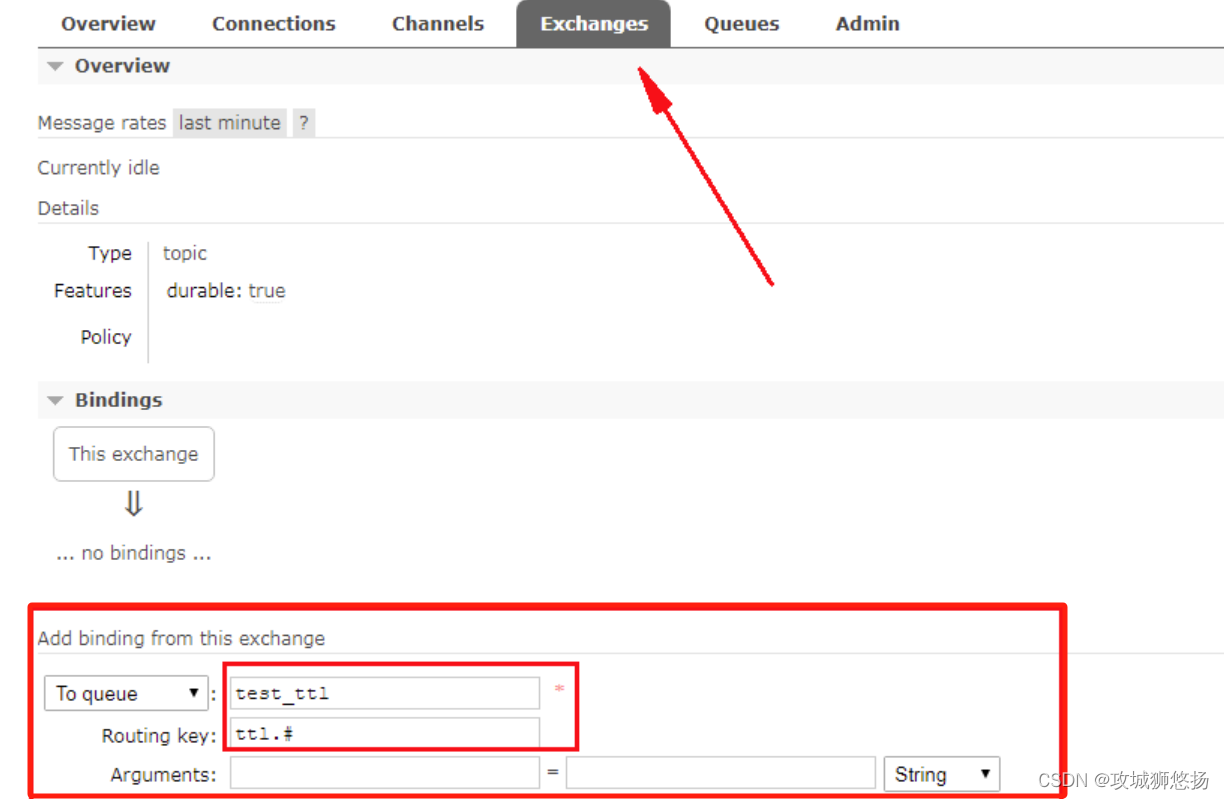
通过管控台发送消息
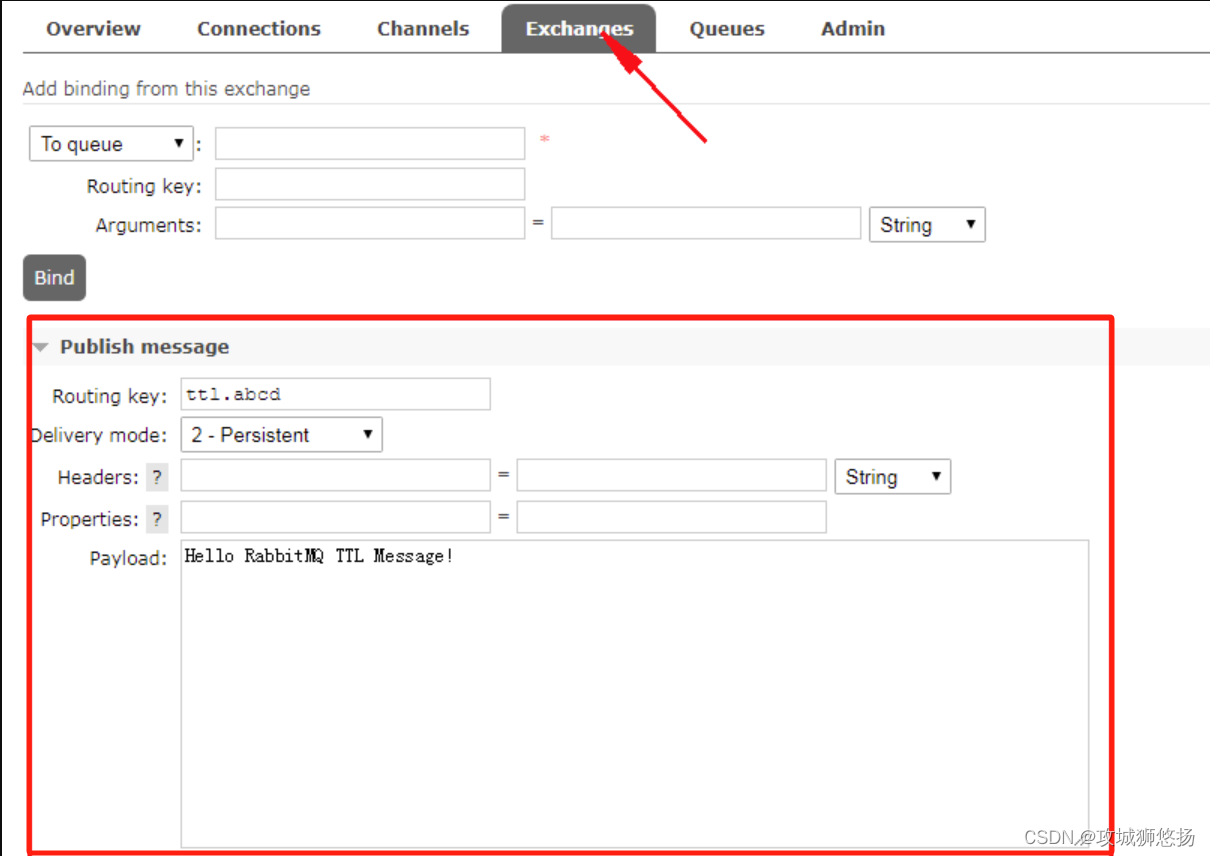
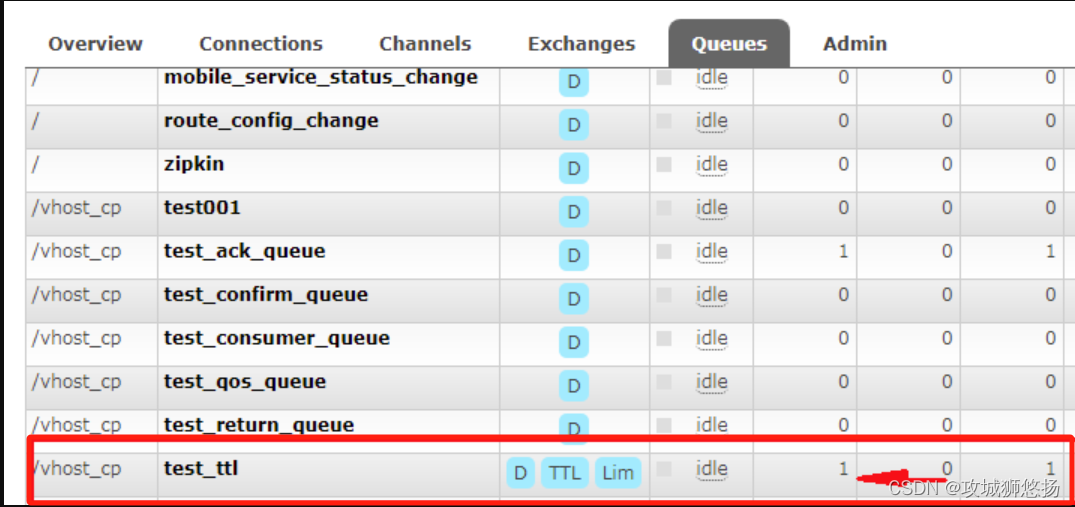
消息未处理自动清除
生产端设置过期时间
AMQP.BasicProperties properties = new AMQP.BasicProperties.Builder()
.deliveryMode(2)
.contentEncoding("UTF-8")
.expiration("10000")
.headers(headers)
.build();
这两个属性并不相同,一个对应的是消息体,一个对应的是队列的过期。
7. 死信队列
7.1 概念理解
死信队列:DLX,Dead-Letter-Exchange
RabbitMQ的死信队里与Exchange息息相关
- 利用DLX,当消息在一个队列中变成死信(dead message)之后,它能被重新publish到另一个Exchange,这个Exchange就是DLX
消息变成死信有以下几种情况
- 消息被拒绝(basic.reject/basic.nack)并且requeue=false
- 消息TTL过期
- 队列达到最大长度
DLX也是一个正常的Exchange,和一般的Exchange没有区别,它能在任何的队列上被指定,实际上就是设置某个队列的属性
当这个队列中有死信时,RabbitMQ就会自动的将这个消息重新发布到设置的Exchange上去,进而被路由到另一个队列。
可以监听这个队列中消息做相应的处理,这个特征可以弥补RabbitMQ3.0以前支持的immediate参数的功能。
7.2 代码演示
- 死信队列设置:
- 首先需要设置死信队列的exchange和queue,然后进行绑定:
Exchange:dlx.exchange
Queue:dlx.queue
RoutingKey:# - 然后我们进行正常声明交换机、队列、绑定,只不过我们需要在队列加上一个参数即可:arguments.put(“x-dead-letter-exchange”,”dlx.exchange”);
- 这样消息在过期、requeue、队列在达到最大长度时,消息就可以直接路由到死信队列!
7.2.1 生产者
public class Producer {
public static void main(String[] args) throws Exception {
//创建ConnectionFactory
Connection connection = ConnectionUtils.getConnection();
Channel channel = connection.createChannel();
String exchange = "test_dlx_exchange";
String routingKey = "dlx.save";
String msg = "Hello RabbitMQ DLX Message";
for(int i =0; i<1; i ++){
AMQP.BasicProperties properties = new AMQP.BasicProperties.Builder()
.deliveryMode(2)
.contentEncoding("UTF-8")
.expiration("10000")
.build();
channel.basicPublish(exchange, routingKey, true, properties, msg.getBytes());
}
}
}
7.2.2 消费者
public class Consumer {
public static void main(String[] args) throws Exception {
//创建ConnectionFactory
Connection connection = ConnectionUtils.getConnection();
Channel channel = connection.createChannel();
// 这就是一个普通的交换机 和 队列 以及路由
String exchangeName = "test_dlx_exchange";
String routingKey = "dlx.#";
String queueName = "test_dlx_queue";
channel.exchangeDeclare(exchangeName, "topic", true, false, null);
Map<String, Object> agruments = new HashMap<String, Object>();
agruments.put("x-dead-letter-exchange", "dlx.exchange");
//这个agruments属性,要设置到声明队列上
channel.queueDeclare(queueName, true, false, false, agruments);
channel.queueBind(queueName, exchangeName, routingKey);
//要进行死信队列的声明:
channel.exchangeDeclare("dlx.exchange", "topic", true, false, null);
channel.queueDeclare("dlx.queue", true, false, false, null);
channel.queueBind("dlx.queue", "dlx.exchange", "#");
channel.basicConsume(queueName, true, new MyConsumer(channel));
}
}
7.2.3 自定义类:MyConsumer
public class MyConsumer extends DefaultConsumer {
public MyConsumer(Channel channel) {
super(channel);
}
@Override
public void handleDelivery(String consumerTag, Envelope envelope, AMQP.BasicProperties
properties, byte[] body) throws IOException {
System.err.println("-----------consume message----------");
System.err.println("consumerTag: " + consumerTag);
System.err.println("envelope: " + envelope);
System.err.println("properties: " + properties);
System.err.println("body: " + new String(body));
}
}
7.2.4 测试结果
运行Consumer,查看管控台
查看Exchanges
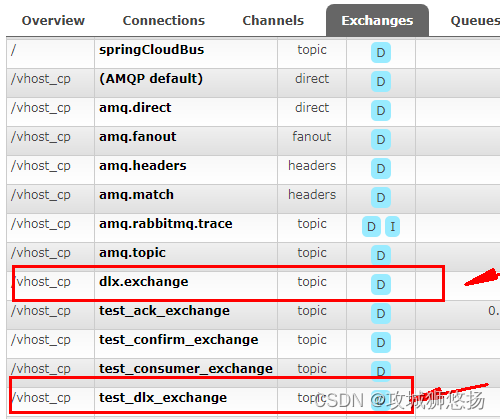
查看queue
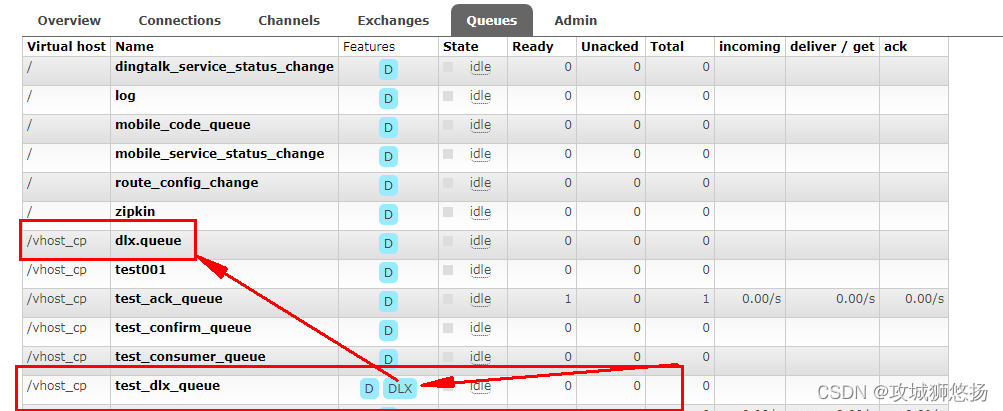
可以看到test_dlx_queue多了DLX的标识,表示当队列中出现死信的时候,会将消息发送到死信队列dlx_queue中
关闭Consumer,只运行Producer

过10秒钟后,消息过期
在我们工作中,死信队列非常重要,用于消息没有消费者,处于死信状态。我们可以才用补偿机制。
小结
本次主要介绍了RabbitMQ的高级特性,首先介绍了互联网大厂在实际使用中如何保障100%的消息投递成功和幂等性的,以及对RabbitMQ的确认消息、返回消息、ACK与重回队列、消息的限流,以及对超时时间、死信队列的使用
